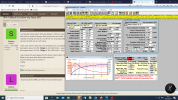Your intuition seems sound. Several things from your post worthy of investigating before you start shooting again.
Observation:
Lights start going off when you are getting 3031 fps with a load published at 2960 fps- a delta of 60 fps. I immediately find that suspect. Without being able to find anything on how Remington measures velocity on their ammunition, it is hard to tell. We all know the trick, publish the velocity from a high end 26" barrel and slap it on the box. I do not think I have ever seen factory rifles produce velocities above published velocity. I normally expect to see 50-200 fps less than published.
Hypothesis:
The velocities you are getting could be from a chronograph giving an erroneous reading. A lot of the less expensive optical chronographs are notorious for erroneous readings. A slight bend or flex in the body on two, closely spaced optical sensors can skew results greatly. This is a diagram showing how it can happen from the folding style chronographs. A similar effect could happen from a misaligned sensor that is just hot-glued in there, an over-tightened screw, etc.
View attachment 252300
https://precisionrifleblog.com/2012/07/20/chronograph-accuracy-tips-15-practical-tips-to-increase-accuracy-reliability/
Perhaps check your chronograph against a LabRadar, Oehler, Magnetospeed, etc.
In regards to reloading:
Looking at what I have for information Nosler load data goes from 200gr-210gr. This is only for their bullets.
Compare the longest 210 gr bullet Nosler makes, the Accubond LR, to the ELD-X.
Accubond LR o.a.l 1.550"
Hornady 212-gr ELD-X 1.600"
The difference in length: +0.050" from Nosler to Hornady.
The ELD-X is also 2 grains heavier.
None of this says DO NOT use RL26 with that bullet. I'm sure there are TONS of folks who already do. I would suggest you STOP until you find published data for it. Again, your intuition is right. When powder ignites, you are dealing with >60,000 PSI. Small changes can lead to major jumps in pressure. This stuff does not scale linearly. Manufacturers can be a phenomenal resource. Quickloads might help guide you, but it is never a tool from coming up with a new recipe. Keep consulting others who load with that powder and bullet.
Keep us updated with the progress and of course, don't blow yourself up!

